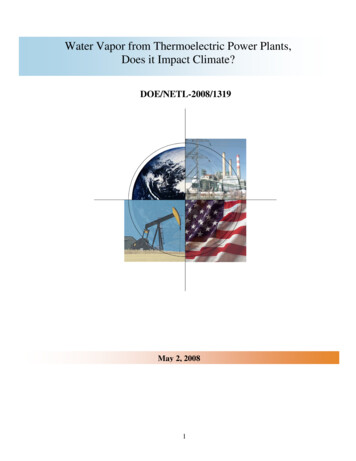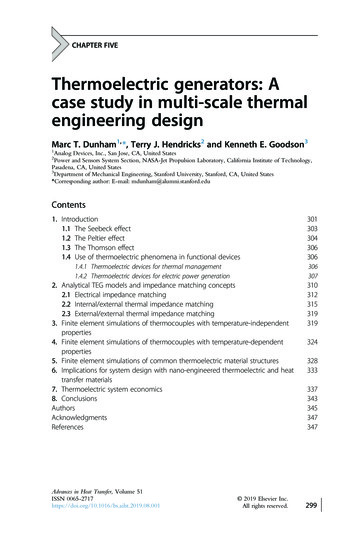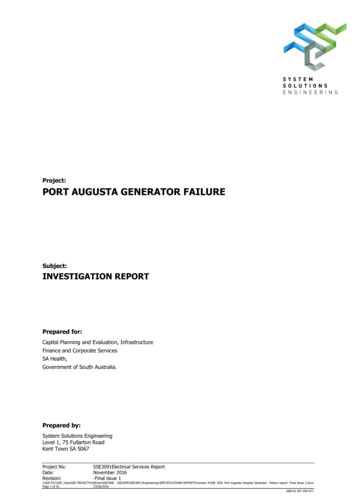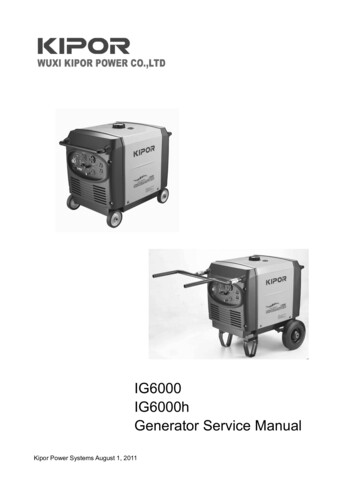
Transcription
PROCEEDINGS, Thirty-Ninth Workshop on Geothermal Reservoir EngineeringStanford University, Stanford, California, February 24-26, 2014SGP-TR-202A 1 KW Thermoelectric Generator for Low-temperature Geothermal ResourcesChangwei Liu, Pingyun Chen, Kewen Li*China University of Geosciences, Beijing29 Xueyuan Road, Beijing 100083, China*Corresponding author e-mail: likewen@cugb.edu.cnKeywords: One KW TEG system; direct power generation; thermoelectric effect; TEG; low temperatureABSTRACTMost of the current thermal power-generation technologies must first convert thermal energy to mechanical work before producingelectricity. Thermoelectric generation technology, as one entirely solid-state energy conversion method, can directly transformthermal energy into electricity by using thermoelectric transformation materials. A thermoelectric power converter has no movingparts, and is compact, quiet, highly reliable and environmentally friendly. Therefore, the whole system can be simplified andoperated over an extended period of time with minimal maintenance. In addition, it has a wider choice of thermal sources. It canutilize both the high- and low-quality heat to generate electricity. The low-quality heat may not be utilized effectively byconventional methods such as ORC technology.In this study, a direct heat to electricity (DHE) technology using the thermoelectric effect, without the need to change throughmechanical energy, was applied to harvest low-enthalpy thermal work. Such a power generation system has been designed and builtusing thermoelectric generator (TEG) modules manufactured using a new technique. The targets of this technique were low costand high thermal to electricity efficiency. Experiments have been conducted to measure the output power at different conditions:different inlet temperature and temperature differences between hot and cold sides. TEG modules manufactured with differentmaterials have also been tested. The power generator assembled with TEG modules had an installed power of 1 KW at atemperature difference of around 120 C. The power generated by the thermoelectric system is almost directly proportional to thetemperature difference between the hot and the cold sides. The cost of the DHE power generator is much lower than that ofphotovoltaics (PV) in terms of equivalent energy generated. The TEG systems are ready to be applied practically in manygeothermal sites with low temperature resources, including oil fields where fossil and geothermal energies are co-produced.1. INTRODUCTIONGeothermal energy is one of the largest sources of renewable energy according to the World Energy Assessment (WEA, 2000).Among the vast number of geothermal resources, a great proportion are low temperature ( 150oC). Most of the potential coproduced geothermal energy associated with oil and gas fields is in the range of low temperature (Erdlac, et al, 2007, Li, et al., 2007,Xin, et al., 2012, Bennett, et al., 2011). The frequently-used technology to generate electricity by using this type of low enthalpygeothermal or other thermal energy is Organic Rankine Cycle (ORC) binary power generator. A noteworthy example is the 250 kWORC plant in Chena Hot Springs, Alaska, which produces electricity from a very low temperature (74 C) geothermal resource(Erkan, et al.,2007 ).Compared with solar and wind systems, geothermal energy has many advantages, including being impervious to weather changes,having a stable base load, and high thermal efficiency (for high temperature geothermal resource). However, the total capacity ofinstalled geothermal power lags behind solar and wind. In 2011, the installed power of PV and wind were 70 and 240 GW,respectively. According to Geothermal Energy Association (GEA), the total geothermal power installed in the world was about 11.2GW as of May 2012. The average annual growth rate of geothermal power is about 2%, while that of PV is about 58% during thesame period of 2006-2011 and up to 74% in 2011 (REN 21, 2012).Li (2013) discussed likely factors leading to the low growth rate of geothermal energy. The main factors include high initialinvestment, high exploration risk, long payback and construction time, difficulty to assess resource, and difficulty to modularize. Li(2013) also pointed out possible directions to accelerate the growth of geothermal power. One of the solutions may be the largescale utilization of TEG technology.Since 1821, many researches have investigated the application of thermoelectric materials. Thacher (2007) developed athermoelectric power generator using car exhaust heat. The maximum power output reached 255 W. Kajikawa and Onishi (2007)developed an advanced thermoelectric conversion exhaust system in a light truck. Maneewan and Chindarksa (2009) investigatedthe characteristic and performance of TEG modules for power generation at low temperatures. The unit achieved a power output of2.4 W with a temperature gradient of approximately 150 . The conversion efficiency was about 3.2%. Niu et al. (2009)constructed an experimental thermoelectric generator unit; a comparison of the experimental results with those from the previouslypublished numerical model was analyzed. Hsu (2011) developed a low-temperature waste heat system to utilize the car exhaust heatas well. When the engine rate boosted to 3500 RPM, 12.4 W of maximum power output was obtained at an average temperaturedifference of about 30 C.Numerical modeling of TEG systems has also been investigated. Esartea et al. (2001) analyzed the influence of fluid flow rate, heatexchanger geometry, fluid properties and inlet temperatures on the power supplied. Chen et al (2005) assumed that heat-transferobeys the linear phenomenological heat-transfer law and studied the performance of multi-element thermoelectric-generators.Yamashita (2008) developed new thermal rate equations by taking the temperature dependences of the electrical resistivity andthermal conductivity of the thermoelectric (TE) materials into the thermal rate equations on the assumption that they vary linearlywith temperature. Freunek et al. (2009) described an analytical model for thermoelectric generators and found that the influence of1
Liu et al.the Peltier heat on the output power was about 40%. Eisenhut and Bitschi (2006) derived an analytic model based on convectiveheat sources. Liu (2012) presented the designs of electricity generators based on thermoelectric effects using heat resources of smalltemperature differences. Karabetoglu et al. (2012) reported the approach to characterizing a thermoelectric generator at lowtemperatures. Xiao et al. (2012) designed a solar thermoelectric generator using multi-stage thermoelectric module; the totalconversion efficiency was 10.52%. Suter et al. (2012) established a numerical model for a 1kWe thermoelectric stack for powergeneration, which may help define the configuration and operating parameter range that are optimal from a commercial standpoint.Wang et al. (2013) presented a mathematical model of TEG and preliminary analysis of factors. Kim (2012)derived a modeldescribing the interior temperature difference as a function of the load current of a thermoelectric generator (TEG) and the resultsshowed approximately 25% of the maximum output power is lost because of the parasitic thermal resistance of the TE module usedin the experiment.Thermoelectric generation technology (2006), as one entirely solid-state energy conversion method, can directly transform thermalenergy into electricity by using thermoelectric transformation materials. A thermoelectric power converter has no moving parts, andis compact, quiet, highly reliable and environmentally friendly. Therefore, the whole system can be simplified and operated over anextended period of time with minimal maintenance. In addition, it has a wider choice of thermal sources. It can utilize both thehigh- and low-quality heat to generate electricity. The low-quality heat may not be utilized effectively by conventional methodssuch as ORC technology.In this study, we built a power generation system using TEG modules and conducted experiments to measure the output power atdifferent temperature gradients and other conditions. We also tested the efficiency of TEG modules manufactured with differentmaterials. The cost of the power generator using TEG technology was estimated and the results showed that TEG technology wascompetitive to PV technology. This report is modified from the previous version (Li, et al., 2013).2. POWER TESTING OF DIFFERENT TEG MODULESWe tested five different modules with different semi-conduct materials in order to find the TEG with the maximum output at aspecific temperature difference. Fig. 1 shows the schematic of the module tests. The TEG module was clamped tightly in betweentwo containers, one was the hot side with a high temperature and another was the cold side with a low temperature.Figure 1: SchematicFigure 1: Schematic of the module test.Table 1 lists the size and the approximate cost of each module. Module 5 was the most expensive TEG and Module 4 was thecheapest one.Table 1: Property of different TEGs.TypeSize(cm2)Cost(US )Module 11610.5Module 2164.5Module 3167.7Module 4163.4Module 5930.8We kept the temperature on the hot side at about 200 C by using a digital thermostat oil bath and used the tap water as the coolingliquid on the cold side with a temperature of about 20 C. The temperatures of both hot and cold sides were measured and the resultsare shown in Fig. 2. The temperature was measured using two micro-thermocouples with very thin tips. The temperature on the hotside of the modules was stabilized at about 180 C and that on the cold side at about 40 C. The increase in the temperature on thecold side from 20 to 40 C was because of the heat conduction from the hot side through the TEG modules. The temperaturedifference was stabilized at around 140 C. The results illustrate that the test system for thermoelectric power generation was stable.2
Liu et al.Temperature ()200150cold side temperaturehot side temperature1005000500100015002000Time (S)250030003500Figure 2: Temperatures on the hot and cold sides of the moduleWith the stable temperature difference of 140 C, we measured the output power of the five different TEG modules. The results areshown in Fig. 3. Three out of the five thermoelectric modules, Modules 2, 3, and 4, generated power more than 4.5 W.The power ratio (power generated by each TEG module divided by the cost) was calculated and the results are shown in Fig. 4.Obviously, Module 4, with the cost of 3.4 dollar each, has the highest power-cost ratio.5.04.0Power .00.0050100150200250300Time (S)Figure 3: The power generated from different modulesPower-Cost Ratio (W/ 0.0050100150Time (S)200250Figure 4:The power-cost ratio of different TEG modules3300
Liu et al.Note that Module 5 with the highest cost generated less power and yielded the lowest power-cost ratio at a temperature differenceof about 140 C. The above test results do not imply that Module 5 is valueless because Module 5 was originally manufactured foroperating temperatures as high as 300 C. Thus, Module 5 may work better at high temperatures than other modules.Efficiency is the key parameter for power generation. A theoretical model is frequently used to calculate the efficiency of TEG. Fora single thermoelectric module: (1)(2)() (3)Where is the efficiency of the thermoelectric module, P is the output power and Q is the total quantity of heat, is the seebeckcoefficient. K is the heat transfer coefficient,is the load resistance,andis the temperature of the hot and cold siderespectively.̅)((̅) (4) here ̅ () . ZT is the dimensionless figure of merit and its value, ranging from 0.2 to 2, varies with temperature. Theefficiency calculated according to the theoretical model (Eq. 4) is shown in Fig.5. The temperature of cold side was stabilizedinitially at about 30 , and then changed to 40 , 50 , 55 , 60 , 65 , 70 , 75 , 80 , 85 , and 90 respectively. Based onthe current thermoelectric technology, the value of ZT reaches about 1.0 and the efficiency can hardly reach 4% when the hot sidetemperature was around 100 (see Fig. 5).5.0ΔT 60ΔT 55ΔT 50ΔT 45ΔT 40ΔT 35ΔT 30ΔT 25ΔT 20ΔT 10Efficiency ( % )4.03.02.01.00.00.00.51.0ZT1.52.02.5Figure 5: The efficiency of thermoelectric module at different ZT and temperature differenceHowever, the theoretical model (Eq. 4) for calculating the efficiency of thermal power generation using TEG may not be veryaccurate because the seebeck coefficient varies with the temperature or other parameters. Nonetheless we propose a differentapproach to estimating energy conversion efficiency from thermal to electricity. We define this efficiency as the ratio of themaximum electricity generated from thermal energy to the total thermal energy per unit volume of hot water. This efficiency isdefined as “global efficiency”. Using such a concept, it is easier to estimate how many KW of electricity could be generated usingper unit volume (for example, one ton) of hot water with a specific temperature difference, which is a common engineeringquestion of interest. The mathematical models for determining the global efficiency are presented as follows.The total heat energy of the hot liquid can be calculated by the following equation:(5)Where is the total thermal energy of the hot side liquid,the temperature difference between the cold and hot sides.is the specific heat capacity,is the mass of the hot side liquid,isThe maximum electricity generated by TEGs can be calculated:(6)hereis the electric energy generated by TEGs,efficiency of a TEG system can then be computed: Whereis the instantaneous power, t is the time interval at ith step. The global (7)is the global efficiency of a TEG system.4
Liu et al.The experimental procedures for measuring global efficiency from thermal to electricity are described briefly as follow:(1) Fill the hot side container using water with a temperature ofand a mass of m, keep the temperature of cold side liquidat . The total heat energy of the hot liquid can be calculated using Eq. 5.(2) Collect the data of the electricity generated by a TEG system every second until it decreases to zero. The total electricitygenerated from the hot liquid can be calculated using Eq. 6.(3) The global efficiency of a TEG system can be calculated using Eq. 7 with the above experimental data.The efficiency and cumulative electricity output data of module 4 were measured using the above experimental procedures bydecreasing the hot side temperature from 95 to 30 and keeping the cold side temperature at 30 . The experimental results areshown in Fig.10. It is clear that the growth rate of electricity output slows down when the temperature of the hot water on the hotside decrease to 80 . The global efficiency was about 10%, which is greater than . This is because is the instantaneous energyconservation efficiency.200Efficiency (%)101508610045020Cumulative Eletricity Output( J )120100908070605040Temperature Variation of Hot Side (3020)Fig.6. Efficiency and cumulative electricity of thermoelectric module (#4) with the hot side temperature difference3. POWER TESTING WITH DIFFERENT HEAT-CONDUCTING MEDIAThe heat-conducting medium between the ceramic plate and liquid block plays a very important role for the TEG systems. Boththermal conductivity and cost should be taken into account. In this study, some commercially available heat-conducting media wereused for the comparison tests. The property data of the heat-conducting media are shown in Table 2.Table 2: Properties of heat-conducting mediaMedium NameThermal conductivity (W/m·K)Cost(US )Silicone Film6.017.7Graphite Sheets15.02.5Silicone Grease3.024.1The measurements of output power for Module 4 were conducted when different heat-conducting media were used. The hightemperature on the hot side was provided by a thermostatic heating station and the hot side temperature was kept at about 80 C.Tap water with a temperature of 20oC still served as the cold side. At the same time, we chose two different size modules for thetest: 40mm 40mm and 50mm 50mm.The power test results are shown in Fig. 7. The power generated is proportional to the module’s area. In this study, the 40mm40mm size modules were used for the experiments in next section.5
Liu et al.2.52.1462.040cm 40cmPower (W)50cm 0NONEGrahite SheetSilicone FilmSilicone GreaseDifferent Thermal mediumsFigure 7: The effect of area and heat-conducting medium type on output powerAccording to the results shown in Fig. 7, the modules with silicon grease generated 1.424 W and 2.146 W for the heat-conductingmedia with different size, respectively. The silicon grease with a lower thermal conductivity performs better than other media witha higher thermal conductivity. The reason might be due to air trapped between the two plates and heat-conducting media. Note thatthe thermal conductivity of air is 0.023 W/m·K. On the other hand, silicone grease can adhere at the interface tightly, so it may helpthe thermoelectric modules dissipate heat and generate more power. However, the silicone grease has an obvious disadvantage: it’svolatile and easy to dry, leading to performance reduction.Silicone film is not recommended because of its high cost. The graphite sheet may be the most suitable medium due to its highthermal conductivity and low cost, but the air gap weakens the heat-conducting performance.Based on the above experimental results, our approach to assembling the TEG modules in this study was to adhere the graphitesheet at the module’s surface using a trace amount of silica gel which can tolerate 200 . This method not only takes advantages ofthe graphite merit, but also avoids the air gap’s negative effect.4. EXPERIMENTAL SET-UP OF THE POWER GENERATING SYSTEMA 500W TEG power generator was designed after above experimental studies. Its schematic is shown in Fig. 8. The hot water,which was supplied by the thermostatic water bath circulator, simulated the geothermal or hot water and provided heat for thegenerators. Cooling cycle was composed of a water pump and water container. Thermal couples for temperature measurements anddisplayers were installed at the inlet and outlet pipes. The values of voltage, current and power can be collected by the electricalmultimeter.Figure 8: The Schematic of the thermoelectric power generation system6
Liu et al.The 500 W TEG power generator was composed of 100 thermoelectric modules (Module 4). 13 liquid blocks (containers) and someconnection boxes were also used in this system. Fig. 9 shows the picture of the TEG power generator before it was wrapped usinginsulation material.Figure 9: The thermoelectric power generation system before operatingIn order to visually display the experimental results, ten direct-current bulbs were used to utilize the output energy. As shown inFig. 10, ten 15W bulbs (direct current) were lit up with 100 C water on the hot side and 20 C tap water on the cold side of thesystem. The 500 W thermoelectric power generation systems after assembled with the case are shown in the Fig. 11.Hot Liquid InletThermoelectricPower GenerationCold Liquid OutletHot Liquid OutletCold Liquid InletFigure 10: The thermoelectric power generation system lighting up ten 15W bulbs.Figure 11: The 500 W thermoelectric power generation system assembled with the case operated to start the LED displayduring the 2013 exhibition at Shanghai International Expo Center7
Liu et al.We built another TEG apparatus with a power of about 1 KW at a temperature difference of around 120 C after successfullydeveloped the previous one shown in Fig. 11. The new system was shown in the Fig. 12. Altogether 600 modules were used for this1 KW power system, and its volume was only about 0.01. The power of this apparatus (see Fig. 12) could be as high as 2 KW iftemperature difference between the cold and hot sides is greater enough. The maximum temperature on the hot side can be 200 C.Detailed research and field tests on this generator will be conducted in the near future.Figure 12: The 1 KW thermoelectric generator for low-temperature geothermal resourcesNote that the experimental data in the following sections are based on the TEG system shown in Fig. 11, which has a small poweroutput than the apparatus shown in Fig. 12.5. POWER TESTING OF THE 500 W POWER GENERATING SYSTEMThe thermoelectric power generation system as shown in Fig. 11 was operated using 100 C hot water and 20 C tap water. The100 C hot water was supplied by a thermostatic water bath. The power generated by the system at a temperature difference ofabout 80 C is shown in Fig. 13. The power was stabilized at around 160W.200Power (W)1501005000100200300400500Time (S)Figure 13: Power generated from the TEG power system vs. timeThe power output was measured at different temperature differences using the TEG power generator. The purpose was to establishthe relationship between power output and temperature difference. The experimental results are shown in Fig. 14.8
Liu et al.200y 2.6253x - 61.314R² 0.9618Power (W)150100500020406080100Temperature Difference ( )Figure 14: Relationship between power and temperature difference.One can see that the power output increases with the increase in temperature differences almost linearly. We can estimate the poweroutput approximately at a specific temperature difference. For example, a power output of 500 W will be reached at a temperaturedifference of about 200 C. Note that the slope of the power curve shown in Fig. 14 increases with the increase in temperaturedifference. The relationship between power output and temperature difference looks like exponential, which is of great significance.122010Efficiency (%)15861045200100806040Cumulative Electricity Output (kJ)The same experimental method as that applied for single modules was used for the efficiency determination of the 500 W powergeneration system. As shown in Fig.15, the global efficiency was about 9% with the temperature variation from 100 to 30 ofthe hot side. The slope gradually decreases to zero, and the temperature of hot side from 100 to 80 was recommended forpower generation based on the results in Fig. 15.20Temperature Variation of Hot Side ( )Figure 15: Global efficiency and cumulative electricity of geothermal power generation with the hot side temperaturevariationOn the other hand, temperature differences of inlet and outlet of hot side also plays very important role on the efficiency. Both inletand outlet temperature variation of hot side was collected, inlet temperature was changed from 45 to 85 and the outlet was from35 to 75 . The temperature on the cold side was kept at 35 .9
Liu et al.5Th,out 35Efficiency (%)4Th,out 453Th,out 55Th,out 652Th,out 75102030405060708090100Inlet Temperature of Hot Side ( )Figure 16: Efficiency of power generation at different inlet and outlet temperatures of hot sideThe data shown in Fig. 16 are instantaneous efficiency which increases with the increase in temperature at the inlet and the decreasein temperature at the outlet on the hot side. The instantaneous efficiency of the TEG system could reach about 4.5% at the inlettemperature of about 95 and the outlet temperature of 75 . Importantly the instantaneous efficiency increases with the inlettemperature exponentially, and has a stronger dependency on the outlet temperature. Note that the results shown in Fig. 16 aresimilar to the results reported by Sulter et al. (2012).6. COMPARISON OF COST WITH PV AND WIND SYSTEMSCost is a great challenge for almost all of the renewable energy technologies. Based on the experimental results and the data aboutPV and wind system from publications (CWEA,2012,Qian.,2012), we estimated the total cost of the DHE power generator andfound that the cost is close to the PV’s cost in terms of unit installed power. The cost data for solar PV and wind energy are shownin Fig. 17. Also shown in Fig. 17 are the cost data estimated by considering the capacity factor for PV and DHE. A capacity factorof 14% for PV and 90% of DHE (or TEG technology for thermal energy) were chosen. The cost of the TEG system developed inthis study was much lower than those of PV and wind power systems in terms of equivalent energy generated after considering thecapacity factor.70006000Cost, /KW50006324Wind power generationSolar power generationThermoelectric power hout considering capacity factorWith considering capacity factorFigure 17: The cost comparison of wind, solar, thermoelectric power generation7. CONCLUSIONSAccording to the current study, the following preliminary conclusions may be drawn:(1) Two power generators have been built using TEG modules and tested. The power of the first one could reach about 500 W(predicted using experimental data) with a temperature difference of about 200 C between hot and cold sides. An outputpower of over 160 W has been generated under a temperature difference of 80 (hot side temperature was about 100 C andthe cold side was 20 C). The second TEG system could generate over 1 KW at a temperature difference of around 120 C.(2) The instantaneous efficiency of the TEG system reached 4.5% at an inlet temperature of about 95 C on the hot side and atemperature of 30 C on the cold side. This efficiency increases exponentially with the inlet temperature.10
Liu et al.(3) The cost of the TEG system developed in this study was much lower than those of PV and wind power systems in terms ofequivalent energy generated (considering the capacity factor).REFERENCESBennett, K., Horne, R. and Li, K.: “Power Generation Potential from Coproduced Fluids in the Los Angeles Basin,” In: GRC Trans;(2011).Chen, L., Sun, F. and Wu, C.: “Thermoelectric-generator with linear phenomenological heat-transfer law”. Applied Energy (2005);81, 358–64.Eisenhut, C. and Bitschi, A.: “Thermoelectric conversion system based on geothermal and solar heat,” 25th InternationalConference on thermoelectrics, (2006), p.510-515.Erdlac, Jr., Armour, L., Lee, R. and Snyder, S.: “Sorensen M, Matteucci M, Horton J. Ongoing Resource Assessment ofGeothermal Energy from Sedimentary Basins in Texas,” Proceedings of 32nd Workshop on Geothermal ReservoirEngineering, Stanford University, Stanford, California, (2007), January 22-24.Erkan, K., Holdman, G., Blackwell, D. and Benoit W.: “Thermal Characteristics of the Chena Hot Springs Alaska GeothermalSystem,” PROCEEDINGS, Thirty-Second Workshop on Geothermal Reservoir Engineering Stanford University, Stanford,California, (2007), January 22-24.Esartea, J., Minb, G. and Roweb, D.: “Modeling heat exchangers for thermoelectric generators,” J Power Sources 2001; 93:72–6.Freunek, M., Mueller, M. and Ungan, T. Walker, W., Reindl, L.: “New Physical Model for Thermoelectric Generators,” Journal ofelectronic materials (2009), 38, 1214-1220.Hsu, C., Huang, G., Chu, H., Yu, B. and Yao, D.: “Experiments and simulations on low-temperature waste heat harvesting systemby thermoelectric power generators,” Applied Energy (2011), 88(4), 1291-1297.Kim, S.: “Analysis and modeling of effective temperature differences and electrical parameters of thermoelectric generators,”Applied Energy (2012), 102, 1458-63.Kajikawa, T. andOnishi, T.: “Development for advanced thermoelectric conversion exhaust thermoelectric generator in a lighttruck,” Proc Inst Mech Eng Part D J Automob Eng (2007), 221, 95–107.Karabetoglu, S., Sisman, A., Fatih Ozturk, Z. andSahin T.: “Characterization of a thermoelectric generator at low temperatures,”Energy Conversion and Management (2012), 62, 47-50.Li, K., Liu, C., and Chen, P.: “Direct power generation from heat without mechanical work. Proceedings, 38th Workshop onGeothermal Reservoir Engineering Stanford University,” Stanford, California; (2013), February 11-13.Li, K., Zhang, L., Ma, Q., Liu, M., Ma, J. and Dong, F.: “Low Temperature Geothermal Resources at Huabei Oilfield, China”. In:GRC Trans, (2007), p. 31.Li, K.: “Comparison of Geothermal with Solar and Wind Power Generation Systems,” Proceedings, 38th Workshop on GeothermalReservoir Engineering Stanford University, Stanford, California; (2013), February 11-13.Liu, L.: Large-scale Ocean-based or Geothermal Power Plants by Thermoelectric Effects. www.arXiv.org ; (2012).Maneewan, S. and Chindaruksa, S.: “Thermoelectric power generation system using waste heat from biomass drying,” Journal ofelectronic materials 38(7), 974-980.Niu, X., Yu, J. and Wang, S.: “Experimental study on low-temperature waste heat thermoelectric generator”. Journal of PowerSources (2009), 188, 621–6.Renewables: Global Status Report, REN21 (Renewable Energy Policy Network for the 21st Century). Available at: www.ren21.net ,(2012).Rowe, D.: “Review: thermoelectric waste heat recovery as a renewable energy source,” International Journal of Innovation EnergySystem Power (2006), 1:13–23.Suter, C., Jovanovic, Z. and Steinfeld, A.: “A 1kW thermoelectric stack for geothermal power generation–Modeling andgeometrical optimization,” Applied Energy (2012), 99, 379-85.Thacher, E., Helenbrook, B., Karri, M. and Richter, C.: “Testing of an automobile exhaust thermoelectric generator in a lighttruck,” Proceedings of the Institution of Mechanical Engineers, Part D: Journal of Automobile Engineering (2007), p. 95-107.Wang, Y., Dai, C. and Wang, S.: “Theoretical analysis of a thermoelectric generator using exhaust gas of vehicles as heat source,”Applied Energy (2013).WEA.: World Energy Assessment Report. “Energy and the Challenge of Sustainability,” (2000), p. 500.Xiao, J., Yang T.: “Thermal design and management for performance optimization of solar thermoelectric generator,” AppliedEnergy (2012), 93, 33–8.Xin, S., Liang, H., Hu, B. and Li, K.: “Electric pow
The frequently-used technology to generate electricity by using this type of low enthalpy geothermal or other thermal energy is Organic Rankine Cycle (ORC) binary power generator. A noteworthy example is the 250 kW ORC plant in Chena Hot Springs, Alaska, which produces electricity










